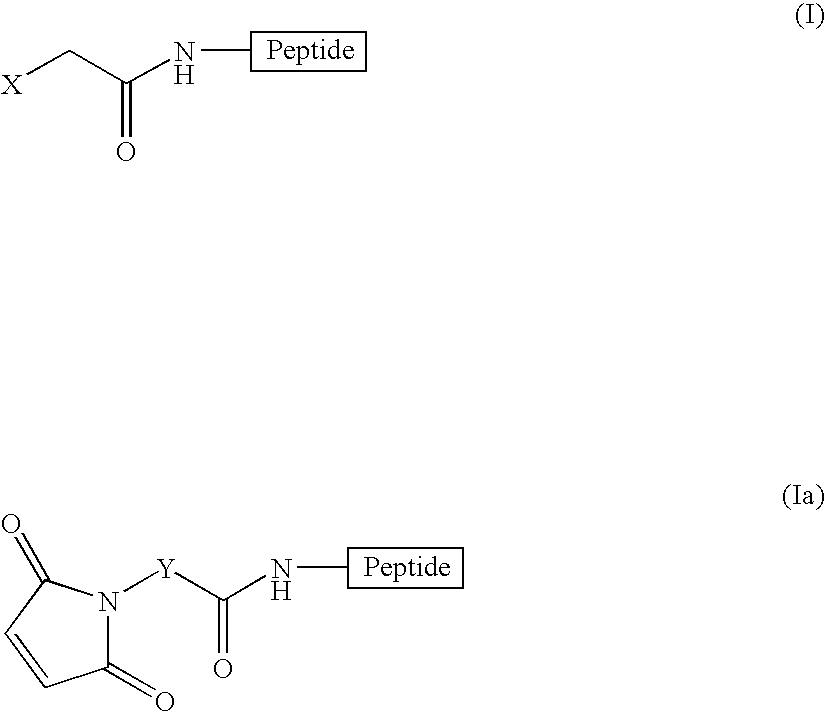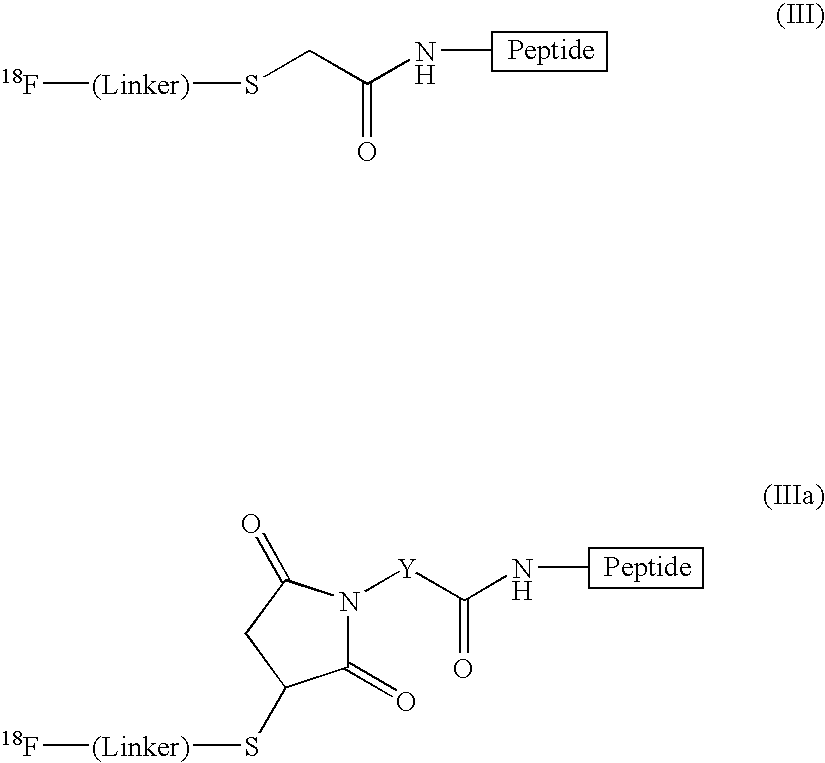Radiofluorination methods
a radiofluorination and method technology, applied in the field of methods and reagents for 18ffluorination, can solve the problems of time-consuming preparation of existing sup>18/sup>f-labelling agents
- Summary
- Abstract
- Description
- Claims
- Application Information
AI Technical Summary
Problems solved by technology
Method used
Image
Examples
example 1
Preparation of 4-Fluoromethyl-N-[2-(tritylsulphanyl)ethyl]benzamide, Deprotection and Site-specific Conjugation to a Chloroacetyl Modified Peptide
1. a) S-Trityl Cysteamine
[0064]
[0065]To a stirred solution of cysteamine (Fluka, 3.85 g, 50.0 mmol) in trifluoroacetic acid (TFA) (50 ml) was added triphenylmethanol (13.0 g, 50.0 mmol). The mixture was stirred at room temperature for 30 min and concentrated. To the residue was added ether (250 ml). Precipitated material was filtered off and washed with ether. The TFA-salt was partitioned between 1 M aqueous KOH solution (150 ml) and ether (150 ml). The phases were separated and the ether phase was dried (MgSO4). The solution was filtered and concentrated and the product was crystallised from ether / n-hexane, giving 9.20 g (58%) of white solid.
1. b) 4-Hydroxymethyl-N-[2-(tritylsulphanyl)ethyl]benzamide
[0066]
[0067]To a solution of S-trityl cysteamine (1.60 g, 5.00 mmol) and 4-hydroxymethylbenzoic acid pentafluorophenyl ester (MilliGen, 1.51 ...
example 2
Preparation of (3-fluoro-propylsulfanyl)triphenylmethane, Deprotection and Site-specific Conjugation to a Chloroacetyl Peptide
2. a) Synthesis of 3-tritylsulfanyl-propan-1-ol
[0076]
[0077]Trityl chloride (27.9 mg, 0.1 mmol) and triethyl amine (49 μl, 0.5 mmol) were dissolved in DCM (2 ml) before 3-mercapto-1-propanol (9 μl, 0.1 mmol) was added. DCM was evaporated under reduced pressure after 6 hours and the crude product purified by reverse phase preparative chromatography (Vydac 218TP1022 column; solvents A=water / 0.1% TFA and B=CH3CN / 0.1% TFA; gradient 30-70 % B over 40 min; flow 10 ml / minute; detection at 254 nm). A yield of 6 mg of purified material was obtained (analytical HPLC: column phenomenex Luna C18,00B-4251-E0: solvents: A=water / 0.1% TFA and B=CH3CN / 0.1% TFA; gradient 30-70% B over 10 min; flow 1.0 ml / minute; retention time 7.73 minutes detected at 214 and 254 nm). Structure verified by NMR.
2. b) Synthesis of methanesulfonic acid 3-tritylsulfanyl-propyl ester
[0078]
[0079]Mesy...
example 3
Deprotection of the Trityl Group and Site-specific Conjugation to the Chloroacetyl Peptide
[0094]
[0095]Deprotection of the trityl group and site-specific conjugation to the chloroacetyl functionalised peptide was carried out as described, in example 1. e) and f) above.
HPLC Method for Examples 4 to 6
[0096]Beckman System Gold®, column: Luna (Phenomenex), C18, 3 μm, 50×4.6 mm i.d.; flow rate 1 ml / min; solvent A: water (0.1%) TFA, solvent B: acetonitrile (0.1% TFA).
[0097]gradient system 1: 1 min 40% B, 15 min 40→80% B, 5 min 80% B
[0098]gradient system 2: 1 min 0% B, 10 min 0→30% B, 5 min 30% B, 5 min 30→80% B
PUM
| Property | Measurement | Unit |
|---|---|---|
| Capacitance | aaaaa | aaaaa |
Abstract
Description
Claims
Application Information
 Login to View More
Login to View More - R&D
- Intellectual Property
- Life Sciences
- Materials
- Tech Scout
- Unparalleled Data Quality
- Higher Quality Content
- 60% Fewer Hallucinations
Browse by: Latest US Patents, China's latest patents, Technical Efficacy Thesaurus, Application Domain, Technology Topic, Popular Technical Reports.
© 2025 PatSnap. All rights reserved.Legal|Privacy policy|Modern Slavery Act Transparency Statement|Sitemap|About US| Contact US: help@patsnap.com



